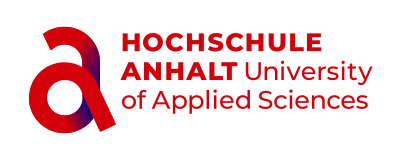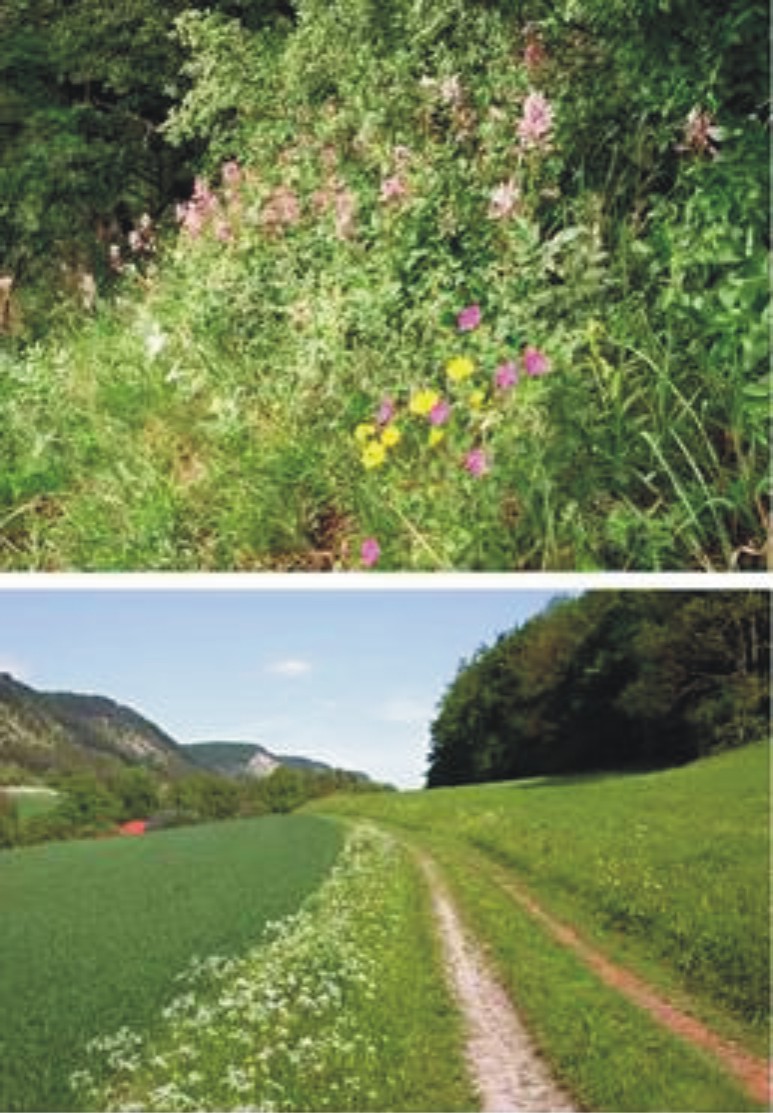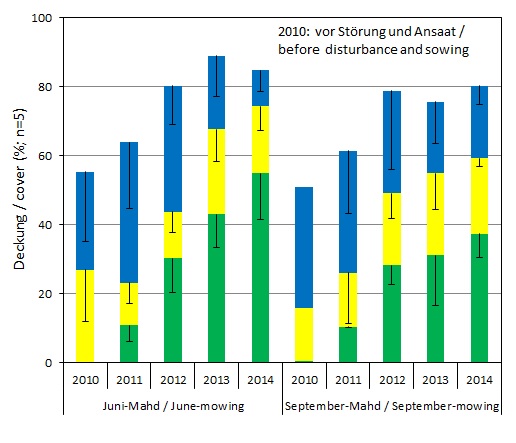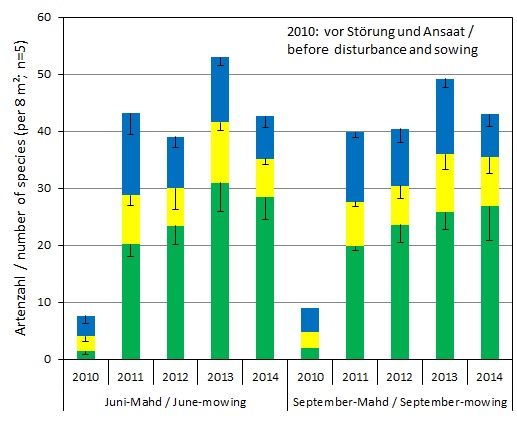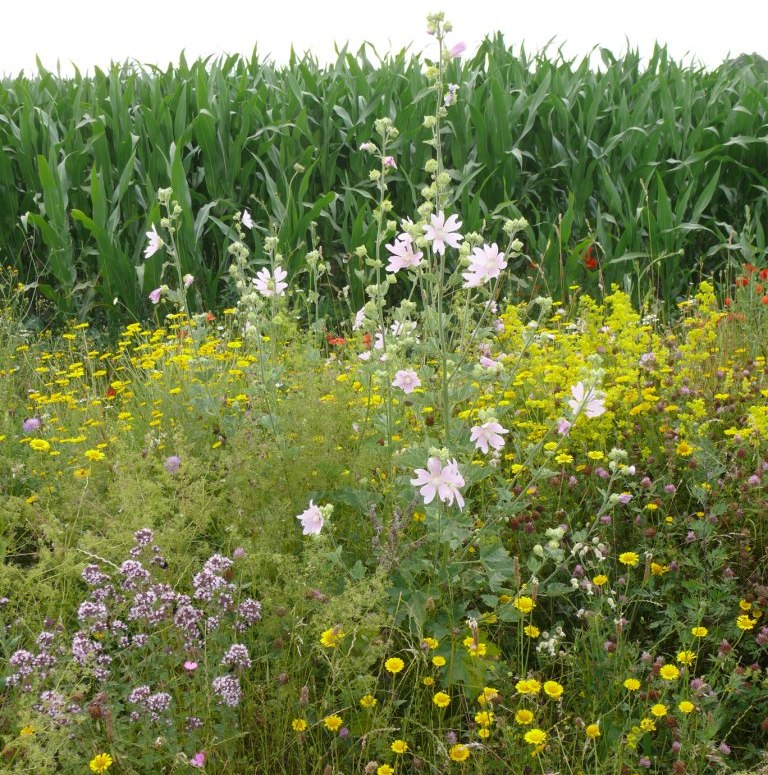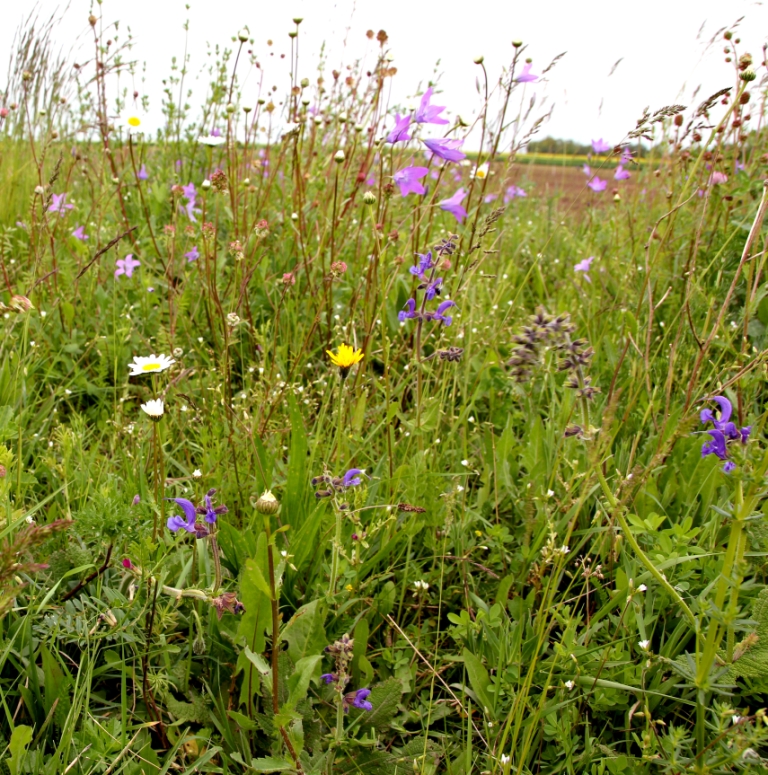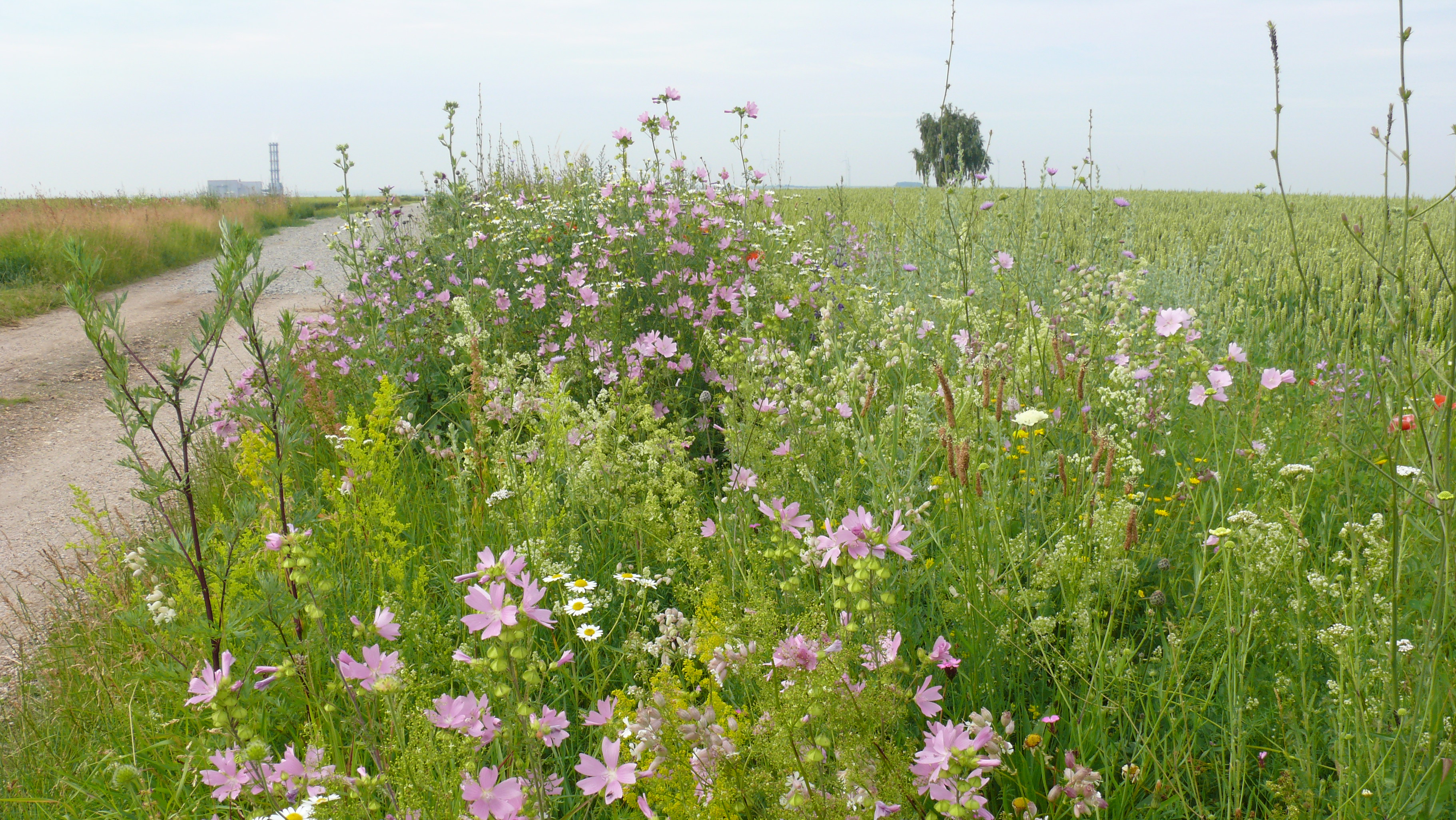Ecological and economical optimisation of methods to diversify field margins in highly productive agricultural landscapes (ProSaum)
Background
Background

Species-rich field margins along hedgerows (above) and arable land (below). (Photos: Sabine Tischew) Herb-rich, perennial field margins along arable fields, meadows, farm tracks, ditches, and hedgerows are important structural elements in agricultural landscapes, providing feeding, breeding, and hibernation habitats for many animals (birds, butterflies, wild bees, hoverflies, grasshoppers, ground beetles, spiders) and, in general, characterising the landscape. In the intensively farmed regions of northern and eastern Germany, existing field margins are mostly species-poor and grass-dominated, thus not able to fulfil their ecological and aesthetic functions.
Unfortunately, in restoration and establishment of fringes and field margins, mostly commercial standard seed mixtures are used, containing horticultural and agricultural varieties, flowering plants of non-native origin (e. g. Petroselinum crispum, Dianthus barbatus, Alcea rosea), and even invasive species such as Bunias orientalis or Lupinus polyphyllus.
Diversification of still-existing field margins and the re-establishment of already vanished field margins establish biotope networks in the landscape, thus contributing to the conservation and enhancement of biological diversity in the concerned region. The use of herb-rich seed mixtures containing 30-40 native species from regional propagation is a decisive precondition for the long-term success of these measures.
Project goals
Project goals
Deficient establishment of species-rich field margins, in regards to the use of seed mixtures of local provenance were analysed and best practice methods for the establishment of site-specific perennial field margins on nutrient-rich sites were tested. The implemented seed mixtures should satisfy aesthetic demands and the developing vegetation should require low management efforts. In addition, the seed mixtures should be suitable not only for restoration and re-vegetation of different field margins, but also for other green spaces. In Saxony-Anhalt, the results of this project were implemented into the agri-environmental scheme for the establishment of flower strips in the CAP funding period 2014-2020.
Pilot trial – Establishment of a field margin along arable land
Pilot trial – Establishment of a field margin along arable land
At the edge of the Ochsendorf test field on the Strenzfeld campus, a block test with six variants and five repetitions was set up at the beginning of October 2010. For the seeding variants, the existing, species-poor grass border was destroyed by milling once and three times. On October 7th, 2010 the milled areas were sown with 49 native, perennial border and meadow species (e.g. field scabious, red pea, dyer's chamomile, medicinal ziest, St. Bellflower, meadow sage, wild mallow, whirlwind). The seed rate was 2 g / m² (approx. 2000 seeds / m²). After sowing, the areas were hand-rolled with a smooth roller.
The original vegetation was preserved in two variants; these areas were mowed once (beginning of October) or three times (beginning of June, mid-July, beginning of October) in 2011. The milled and sown areas were mulched at the beginning of June 2011 as part of development maintenance and mowed at the end of August 2011. Since 2012, half of the areas have been mowed in early summer (mid-June) and the other half in late summer (early September) and the biomass removed.
At the end of September 2010, the Osnabrück University of Applied Sciences in Wallenhorst (Lower Saxony) carried out a comparable experiment with 37 local species.
Results
Up to summer 2011, 86% and from summer 2012-2014 100% of the sown species could be detected on the block system in Strenzfeld. In 2014, the mean coverage of the types of seed on the early mown areas was significantly higher than on the late mown areas. In contrast, the mean number of species has so far only shown minor differences. Tilling / cultivating three times led to significantly higher establishment rates in the first few years compared to a single soil disturbance.
The experiments show that species-poor, grass-dominated field margins develop into species- and flower-rich stands in the 1st year (2-3 tending cuts) through intensive soil disturbance and subsequent sowing with regional wild plant seeds with suitable development care. Early mowing led to higher cover of the target species and less grass cover on the nutrient-rich black earth areas. A combination of earlier and later mowing proved to be particularly advantageous in the project. While the areas mowed in June show a lush blooming aspect in early and late summer, the sown species on the areas mowed in September bloom in midsummer. Due to the decline in the coverings of the types of sowing and the gradual increase in competitive grasses on the September mowing variants, it is to be expected that the variety of flowers on these variants will gradually decrease in the following years, even in midsummer. Therefore, alternating early and late mowing is recommended on nutrient-rich areas. The success of the measures will be followed up in the next few years through vegetation monitoring.

Development of mean cumulative cover of target, accompanying target and non-target species on June- and September-mowing variants between 2010 and 2014. Soil preparation before sowing: tilling once. Green = sown target species, yellow = accompanying species, blue = non-target species. 
Development of mean number of target, accompanying target and non-target species on June- and September-mowing variants between 2010 and 2014. Soil preparation before sowing: tilling once. Green = sown target species, yellow = accompanying species, blue = non-target species. Practical guidelines for establishing fringe communities and field margins

Field margin in the fourth year of development (sown in April 2011); July aspect (photo: Anita Kirmer). 
Field margin in the fourth year of development (sown in April 2011); May aspect (photo: Sabine Tischew). Practical guidelines for establishing fringe communities and field margins
Based on our project results, we made recommendations for planning, implementation, and management of fringe communities and field margins. A guideline to establish flower-rich structures in urban and rural areas can be found in Kirmer et al. (2019).
1. Soil preparation: Establishment success of sown species in grass margins generally increases with greater disturbance. Soil preparation may be accomplished by tilling, grubbing or plowing followed by harrowing to produce a fine seed bed.
2. Sowing time: Late summer sowing (late August to mid-September), shortly before the rainy season starts is most successful. Spring sowing (early March to mid-April) is possible, but risky in years with spring drought. Seed of wild plants require at least 2-3 weeks of moist weather conditions for germination.
3. Sowing method: Drill seeding followed by rolling is recommended. Seeds should be dropped on the soil surface and not covered as most wild species require light for germination.
4. Sowing density: A maximum of 2 g/m² sowing density is recommended. Filler material (e.g. bruised grain) at rates of 10-20 g/m² may be required to improve seed distribution.
5. First year management: Undesirable species (e.g. Atriplex spp., Chenopodium spp.) are effectively reduced with 2-3 cuts to c. 10-15 cm height. Cuttings should be removed, except during drought periods and on sites with low biomass production. Selective mowing is required if problematic species (e.g. Arctium spp., Carduus acanthoides, Cirsium arvense) or invasive neophytes emerge. Timely management during the bud stage and prior to flowering is mandatory.
6. Normal management: On nutrient-rich sites, mowing with removal of biomass in early summer is more successful than late mowing (September). Because stepwise mowing is essential to guarantee continuous flowering for insects, up to half of the site should be mown between mid-May and mid-June and the remainder 8-10 weeks later (between end-July and mid-August). On low-productive, nutrient-poor sites, only half of the sites can be mown (e.g. in early summer), but the mowing schedule must be alternated yearly to avoid grass dominance in uncut parts.
The following materials are available on the subject of "More biodiversity in the agricultural landscape":
- Project operational plan for biodiversity with a lot of information on the topic of biodiversity-promoting measures in arable farming
- Brochures on the subject of "Hems and field borders" and "Perennial flower strips"
- Poster too "Establishment and maintenance of species-rich field margins on productive locations in the central German dry area" (As of June 2018)
Lead partner: Hochschule Osnabrück / Osnabrück University; Prof. Dr. Kathrin Kiehl
Project leaders Anhalt University: Prof. Dr. Sabine Tischew, Prof. Dr. Dieter Orzessek
Researcher: Dr. Anita Kirmer, Stefan Schreiter (M.Sc.), Dipl.-Ing. (FH) Matthias Necker
Funding: Bundesministerium für Bildung und Forschung (FHprofUnt Programm)
Cooperation partner: Landwirtschaftsbetrieb Matthias Saudhof; Agrico Lindauer Naturprodukte AG, Hans-Joachim Wuttig;
Landschaftspflegeverein Saaletal e.V.; Rieger-Hofmann GmbH; Matthias Stolle Wildpflanzenvermehrung und –handel

